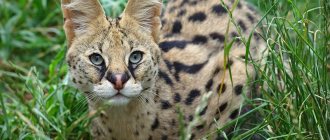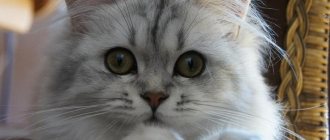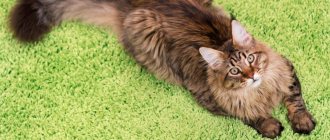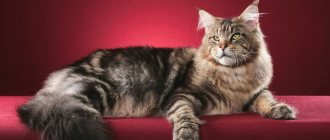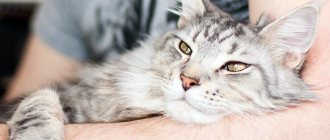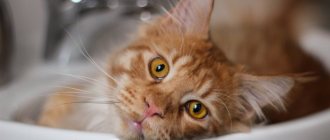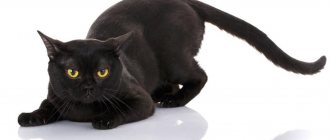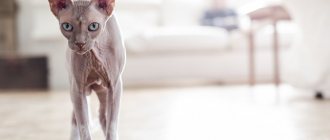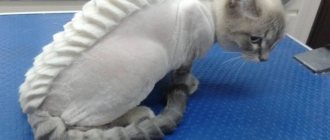The average lifespan of domestic cats is about 15-17 years. The key factors are the living conditions of the animal, the characteristics of the breed, proper care by the owner, and regular visits to the veterinarian.
There are also long-lived cats, living about 20-23 years; their record is often associated with high-quality care and an active lifestyle of the animal itself. How long do Maine Coons live at home?
There is a stereotype that purebred cats are more susceptible to diseases, need mild conditions and do not live long. Actually this is not true.
Representatives of the Maine Coon breed (North American semi-longhair cat) have proven that they are very resilient cats, but require careful care.
With proper care, the lifespan of Maine Coons is more than 12 years; despite their large size, North American semi-longhair cats have good health and are distinguished by their endurance.
According to veterinary clinics and insurance centers, about 50% of North American semi-longhair cats around the world live to the age of 16-17 years.
The rule that the larger the pet, the shorter it lives, applies only to dogs, not cats. The reason lies in the fact that the difference in size between a Maine Coon and an ordinary cat is not as great as between a shepherd dog and a Spitz. Therefore, you should not be afraid to get a large breed cat.
Cats
If you become the owner of a representative of a beautiful breed, then you are probably interested in the question: how long do Maine Coons live as cats at home? We can reassure all owners that with good care and love for their pet, the life of the pet will be long.
On average, Maine Coon cats live about 15-16 years. It is worth noting that females live 1-2 years longer than males. This fact is explained by the characteristics of the breed and natural immunity, which is higher in cats, because they are the ones who have to bear and feed the offspring.
Maine Coons are long-lived
In the United States, a record for life expectancy among Maine Coons was officially registered. The cat Koderoy was born in 1989 and managed to live about twice as long as the representatives of his breed. Success lay in proper nutrition and an active lifestyle, because the cat was by no means a homebody, he spent a lot of time outdoors and hunting. Factors influencing the average lifespan of Maine Coons
To ensure that your North American Longhair cat lives a long life, pay attention to the following factors:
- the pet’s health status (based on the characteristics of the breed, hereditary factors);
- the quality of the conditions in which the cat is kept (the presence of its own space, the absence of dangerous objects and substances in the public domain);
- proper care, including systematic visits to the veterinary clinic and preventive examinations.
How to extend lifespan
Every caring Maine Coon owner wonders what to do to make the cat live as long as possible. To do this, it is necessary to provide the animal with proper care. There are several basic factors that a breeder must take care of.
Nutrition
An inadequate diet and consumption of harmful foods leads to the progression of existing diseases in Maine Coons and the emergence of new ones. Veterinarians recommend choosing the following products for feeding large breed cats:
- lean meat: turkey, beef, chicken, rabbit;
- sea fish;
- fermented milk products: kefir, yogurt, natural yogurt, sour cream;
- quail and chicken eggs - no more than once every 6-7 days;
- fresh, boiled, baked vegetables: broccoli, pumpkin, carrots, cauliflower, zucchini;
- fresh chopped fruits - apples, pears, black currants;
- cereals
You should not overfeed your pet and allow it to become obese. Maine Coons often suffer from hip dysplasia, and excess weight can significantly aggravate the disease.
From industrial feeds, it is recommended to use holistic feeds, as well as premium and super-premium mixtures.
For a complete list of what you can feed your Maine Coon, see the article: “Maine Coon Diet.”
Conditions and care
As practice shows, Maine Coons kept in private homes live longer. The life expectancy of apartment dwellers is somewhat shorter - there the cat is deprived of the opportunity to exercise, breathe fresh air, or “pinch” fresh grass rich in vitamins.
Proper care also affects the lifespan of Maine Coons. The cat should always be kept clean - remove dirt from the nose, wash the eyes and ears, trim the claws. Particular attention must be paid to wool hygiene - you can bathe your pet once every 2-3 weeks, but you need to brush your Maine Coon every day.
It is also necessary to periodically inspect the animal's fur for fleas. To avoid such troubles, it is better to immediately buy a special collar for the cat.
Physical activity
The Maine Coon is a born hunter. Nature inherent in it is the desire to track and catch prey, constant movement. Do not suppress the natural instincts of your pet. After all, a measured, recumbent lifestyle can lead to obesity in a cat.
To maintain physical activity, you need to constantly play with your Maine Coon and walk it at least 2 hours a day. Experienced breeders recommend owners of large cats buy special play complexes for their pets, including houses, scratching posts, multi-level platforms, and vertical posts. Daily exercise will improve your cat's health.
Maine Coons are highly trainable. Therefore, you can choose a simple set of exercises that will not let your pet get bored. Cats of this breed easily follow the commands “sit”, “give paw”, and bring an abandoned toy to the owner.
Sterilization or castration
Castrated and sterilized animals live an order of magnitude longer than pets that have not undergone the corresponding operations. Therefore, if the Maine Coon owner does not plan to breed professionally, veterinarians recommend castration or sterilization. These medical procedures are absolutely harmless to animals.
As a result, the pet will receive inner peace and will not experience seasonal stress. It will also save the energy needed to find a partner. Neutered cats are healthier due to the absence of pregnancies, childbirths, and the absence of nursing kittens.
Spayed and neutered Maine Coons are prone to obesity. Therefore, after the operation, it is recommended to transfer them to specialized industrial feed.
Treatment and prevention
Maine Coons have some health characteristics. This breed of cats is characterized by frequent diseases of the cardiovascular, excretory systems, and musculoskeletal system. Therefore, owners of furry pets need to remember the basic preventive measures aimed at maintaining health:
- The cat should be constantly shown to the veterinarian, at least once every six months. It is also necessary to visit a specialist if your pet behaves strangely: refuses to eat, sleeps a lot, or shows restlessness.
- Starting from 2.5 months, the kitten must be vaccinated against rabies and other diseases (chlamydia, tracheitis, pylencopenia). 7-10 days before vaccination, the animal must be treated for worms, fleas and ticks.
- When feeding a cat natural food, it is recommended, together with a veterinarian, to select the appropriate vitamin and mineral complex (depending on age, gender, nutrition, conditions of detention).
- To maintain healthy teeth and oral cavity, you should introduce solid food into your pet’s diet and buy special sticks for cleaning teeth. Your cat's mouth should be examined by a veterinarian once every six months.
Interesting: “How to choose a Maine Coon kitten.”
How long Maine Coons live is a controversial question. Much depends on the owners. To prolong the life of a pet, you will need to provide it with good care. And the main thing is to show the cat your love and affection. Sometimes this is a decisive factor in increasing the life expectancy of the Maine Coon.
Video: interesting facts about the Maine Coon.
Main causes of premature death
Representatives of the breed are susceptible to the following diseases:
- hypertrophic cardiomyopathy (a hereditary disease that occurs due to gene mutations that affects the contraction of the heart muscles);
- hip dysplasia (can make a young cat disabled and have great difficulty walking);
- back muscle atrophy;
- polycystic kidney disease (presence of cysts from birth that grow and lead to kidney failure).
Death at an early age is possible only from hereditary diseases, so it is extremely important to find a responsible breeder who strictly selects animals for breeding!
Care for claws and teeth
If your cat receives dry food, you can brush your teeth once a month. When receiving soft food, you need to clean it more often - 2-3 times a month. The brush is selected depending on the size of the animal. The animal takes care of its claws on its own, the main thing is that it has a special scratching post. Otherwise, the upholstered furniture or wood in the house will suffer.
Disease Prevention
Many diseases that occur in Maine Coons can be avoided if a number of measures are taken in advance:
- a balanced diet, including premium food, fresh meat, vitamins, minerals, and sufficient water;
- compliance with the vaccination schedule for cats, systematic antiparasitic treatment for preventive purposes;
- spacious living space, maintaining an active lifestyle;
- reduction of stressful situations, for Maine Coons this means a change of housing, owner;
- hygienic care of animals;
- systematic observation by a veterinarian.
Tray training
If a kitten is purchased from a breeder, it means that it is already 2-3 months old, and therefore, it knows what a litter box is.
In this case, the baby only needs to be shown a new place where the kitten should go to the toilet. If, for example, a kitten lives in a large house, it is better to have several such litter trays. Some Maine Coons have a characteristic habit of going to one litter box when needed, and to another when needed. If litter box training occurs on your own, you need to pay attention to the animal’s behavior. You can recognize that a kitten needs a toilet by its behavior:
- the animal begins to worry;
- looks for a secluded place;
- squeaks or meows.
If this happens, you most likely need to plant it in a tray. The owner must carefully move his pet. If the kitten does not understand what is required of him, the person should dig a little into the filler with his hand, thereby letting the cat understand what needs to be done here. If you were unable to do this in time and the kitten made a puddle, you need to wipe it off with napkins and put them in the tray. By the smell, the kitten will understand where he needs to go.
Tray training.
Kitten weight by month depending on breed: table, developmental features
Standards have been developed for the weight of cats at different ages. It is enough to regularly weigh growing pets and compare them with the results of the tables. If the kitten's breed is unknown, weight changes are checked against the table for outbred cats. The attached tables provide data for the most popular breeds - British and Scottish.
How much does a kitten weigh at 2 months?
In the first months of development, British and Scottish females gain weight more slowly than their outbred peers. This is probably due to the fact that the immunity of outbred cats is stronger. These are the disadvantages of purebred breeding before random crossing.
Be sure to read: What food should you feed your adult Scottish Fold cat and kitten? The average weighing results are shown in the table.
| Breed | Age, months | Floor | Live weight, kg |
| British, Scots | 2 | Cats | 1,35±0,35 |
| Cats | 0,68±0,25 | ||
| Outbred | Cats | 1,30±0,20 | |
| Cats | 0,8±0,25 |
In the first months of life, cats grow much faster than cats. With unbalanced feeding, the kittens' weight gain will be significantly lower.
How much does a kitten weigh at 3 months?
Three-month-old kittens continue to gain weight rapidly. But, British and Scottish cats grow slower than outbred cats. Cats grow at the same rate.
| Breed | Age, months | Floor | Live weight, kg |
| British, Scots | 3 | Cats | 2,0±0,5 |
| Cats | 1,25±0,25 | ||
| Outbred | Cats | 2,0±0,30 | |
| Cats | 1,5±0,25 |
It is not so much the live weight that is of decisive importance as the proportionality of development.
There are 5 degrees of fatness:
- thinness;
- weight deficiency;
- norm;
- excess weight;
- obesity.
If the baby's ribs and pelvic bones are clearly visible, you need to add food or consult a veterinarian for advice.
How much should a kitten weigh from 4 to 6 months?
British and Scottish cats begin to develop ahead of outbred cats at the age of five months, and cats at the age of six months. Outbred pets stop developing.
| Breed | Floor | Age, months | Live weight, kg |
| British, Scots | Cats | 4 | 2,6±0,6 |
| 5 | 3,4±0,8 | ||
| 6 | 4,2±1,2 | ||
| Cats | 4 | 2,0±0,3 | |
| 5 | 2,5±0,3 | ||
| 6 | 2,9±0,6 | ||
| Outbred | Cats | 4 | 2,7±0,4 |
| 5 | 3,0±0,4 | ||
| 6 | 3,2±0,5 | ||
| Cats | 4 | 2,5±0,3 | |
| 5 | 2,6±0,4 | ||
| 6 | 2,7±0,6 |
After six months, kittens are transferred to two feedings a day. Feed consumption stops increasing, although weight gain continues.
Kitten weight from 6 to 12 months: table
Bone growth ends at one year of age, although weight continues to increase, mainly due to fat. The table shows the dynamics of the live weight of kittens from six months to twelve months of age.
| Breed | Floor | Age, months | Live weight, kg |
| British, Scots | Cats | 6 | 4,2±1,2 |
| 8 | 4,7±1,3 | ||
| 10 | 5,4±1,3 | ||
| 12 | 5,7±1,3 | ||
| Cats | 6 | 2,9±0,6 | |
| 8 | 3,3±0,8 | ||
| 10 | 3,6±0,8 | ||
| 12 | 3,8±0,8 | ||
| Outbred | Cats | 6 | 3,2±0,5 |
| 8 | 3,4±0,6 | ||
| 10 | 3,7±0,7 | ||
| 12 | 4,2±0,8 | ||
| Cats | 6 | 2,7±0,6 | |
| 8 | 2,7±0,3 | ||
| 10 | 3,2±0,8 | ||
| 12 | 3,5±0,5 |
Be sure to read:
Kobi cat with beautiful eyes - what kind of breed: truth or fiction, description, character, care
One-year-old Scottish and British females are ahead in weight of their outbred peers, and the advantage of purebred cats reaches one and a half kilograms.
Nutritional features depending on the circumstances
When preparing a diet for your pet, the following factors should be taken into account:
- age of the animal;
- health status;
- history of sterilization (castration) operations;
- for cats – bearing and feeding offspring.
Age factor
The composition and quantity of feed, diet must be adjusted in accordance with age needs. A growing organism needs “building” material, the source of which is food and vitamin and mineral supplements.
Up to 4 months, a Maine Coon kitten should be fed small portions 5-6 times a day. Gradually, the number of feedings decreases and by 12 months the growing baby switches to 2 meals a day.
By this time, the composition of the feed should also change. A mature body does not experience the same needs as during the period of growth.
Therefore, you should not offer a mature cat food intended for kittens, and babies should not be fed “adult” food.
Nutrition during illness
Despite the fact that representatives of the breed are distinguished by their strong physique and endurance, they may experience health problems due to unfortunate heredity.
The table shows diseases characteristic of the Maine Coon breed:
| Disease | Recommendations for treatment and prevention |
| Urolithiasis disease | To prevent the disease, it is necessary to exclude fish and economy-class food from the diet, and ensure an optimal drinking regime. For therapeutic and preventive purposes, veterinary foods from the Urinary series (Royal Canin Urinary S/O, Purina Pro Plan Urinary, Eukanuba Veterinary Diets Urinary Oxalate) should be used. |
| Joint pathology | For the purpose of prevention, preference should be given to high-quality feed, which includes the medicinal substances chondroitin and glucosamine. To treat the disease, in case of obesity with increased stress on the joints, the pet should be switched to veterinary feed products (Eukanuba Veterinary Diets Urinary Struvite for Cats Dry, Hill's Feline j/d.) |
| Hypertrophic cardiomyopathy | The animal must be under the supervision of a veterinarian. It is recommended to reduce the amount of salt in the diet. |
Feeding castrated (sterilized) animals
The composition of the feed and diet for castrated (sterilized) individuals should be selected in such a way as to minimize the likelihood of obesity. To prevent urolithiasis, it is necessary to choose feed with a reduced content of phosphorus and magnesium.
The volume of liquid drunk should be 3 times the amount of dry food eaten. In case of insufficient consumption, the following methods can be taken:
- offer food soaked in water;
- switch partially or completely to wet food;
- switch your pet to home-cooked meals.
Nutrition for pregnant and lactating cats
If the expectant mother is accustomed to eating ready-made food, she should not be switched to natural food. In this case it is necessary:
- switch to special super-premium food for pregnant and lactating cats;
- introduce kitten food (dry and wet) into the diet.
If your cat ate natural foods before pregnancy, you need to adjust its menu. The following products should be excluded:
- fish (increases the load on the kidneys);
- vegetables that can cause intestinal disorders (cabbage, beets);
- products containing spices.
Milk must be included in the diet.
In the first trimester, the cat should be fed 2 times a day. In the middle of pregnancy - 3 times, increasing the daily norm by 50%. On the eve of birth, feeding should be frequent (5-6 times a day) using small portions.
With a natural diet, pregnant and lactating cats need special vitamin and mineral supplements. Any drug must be prescribed by a veterinarian.
A nursing cat is also given fractional meals, thanks to which it is possible to avoid additional stress on the body. During lactation, the animal must consume large amounts of fluid. In addition to water, you can offer your cat milk and low-fat broth.
Maine Coon exterior
Connoisseurs of the breed confidently claim that it was formed as a result of mixing the blood of a cat and a raccoon. Some of them suggest that there are also features inherent in the lynx.
One way or another, the animals are distinguished by their rare beauty. In order to describe in detail the representatives of the Maine Coon genus, it is necessary to pay attention to their characteristic features.
These include the following differences:
• the size of the animals reaches approximately one hundred and thirty centimeters, their height is up to half a meter, and up to four years they rapidly increase; • a well-developed adult Maine Coon cat weighs about ten kilograms, females - about six kilograms; • the color of animals can be very diverse, the most common are white, spotted, red, gray, and black; • their fur is very thick, long and silky to the touch;
- Slim physique. The strong and flexible body is elongated, the paws are large;
- the bases of the hind limbs are slightly enlarged, thanks to which the cat can stand on its hind legs without leaning on anything;
- the tail is long, fluffy and luxurious;
• the appearance of Maine Coons is very attractive. Cats have the following features: a large, elongated head, long, mobile ears, large, spaced eyes, and thick fur on the ears, crowned with tassels on top.
The average lifespan of animals is up to twenty years.
It is also important to dwell on how a Maine Coon cat differs from a male cat. First of all, of course, the size. The cat is much larger and has more developed muscles.
But the representatives of the fair sex of the American breed are characterized by extraordinary affection, tenderness, and devotion to their owners and other animals living in the house. They are capable of true, sometimes selfless love. They simply idolize the person, but they also maintain invariably friendly relations with their fellow residents.
Details about swimming
Most representatives of the breed treat water with enviable calm, but some individuals can perceive water aggressively. Therefore, raising a Maine Coon and teaching it to bathe must begin at a young age. In any case, the animal should be washed with the doors closed, since this way it will definitely not break free and will not catch a cold due to the draft.
Despite the fact that the breed is considered semi-longhaired, bathing requires compliance with certain rules:
- Before the procedure, the animal must be combed and examined for minor wounds, as well as its claws trimmed and its ears cleaned.
- It is better to bathe not in the bathtub itself, but in a basin or sink, filling the container with warm water to 10 cm.
- To prevent paws from slipping and scratching the coating of the basin, you can lay down a terry towel, but, as experience shows, not every cat is okay with this.
- When washing, it is important to hold your pet firmly by the scruff of the neck. This should be done gently so as not to harm him.
- With your other hand you need to take a large sponge and wet it. Then, use it to rub the shampoo into the animal’s fur. Most likely, after this the pet will calm down.
- The detergent should be applied using a squeezing motion. You should not rub from side to side, as this may tangle the fur.
- If the animal is not infected with parasites, then its head does not need to be touched. If an invasion occurs, then lather it carefully, avoiding foam getting into the eyes, nasal passage and ears.
- After washing, the foam is washed off under a watering can; it is better to help rinse with your hand. The stream should flow with low pressure, and the shower itself should be kept at a distance of at least 2 cm.
- To keep the coat shiny and shiny, use a cat conditioner, which can be removed with water a few minutes after application.
Note! Human shampoos are not suitable for cats. For these cases, special zoo shampoos and other products should be used. Remember, bathing is stressful for your pet. He will endure the procedure much easier if you talk to him kindly and encourage him in every possible way.
Upon completion of the procedure, you should dip your pet’s fur with a paper or terry towel, after which you can begin drying. If your four-legged friend is not afraid of a hair dryer, then this method will be optimal because it is fast. Otherwise, you can leave the wool to dry naturally, but you should avoid drafts.
After drying, the animal is combed according to the following scheme:
- from bottom to top - on the chest, throat, ears and cheeks;
- up - on the sides;
- from the center in different directions - on the stomach;
- paws fluff up.
It is better not to carry out the procedure too often, as this may disrupt the oiliness of the skin. It is advisable - less than once a month, but before exhibitions and after contamination, you can wash your pet more often.
Description of the breed
Maine Coons have very distinctive fur.
It is usually long, shaggy and very smooth along the body. The fur is longest at the front and on the tail, which is soft and fluffy, with rings of darker coloring around it.
Eyes can vary in color, including green, blue, gold or copper.
The eyes are more rounded than other cat breeds and very large.
The faces are small, with high cheekbones, while the cats have wide chests and their bodies are long.
Adapted by nature to withstand harsh weather conditions, they also have well-padded furry paws.
- Black
- Blue
- Cream
- White
- Black and white
- Blue and white
- Cream and white
- Red and white
Maine Coon Tabby
The Maine Coon Tabby has the traditional tabby cat fur. With spots and spots of different colors all over the fur.
Although the most common Maine Coon Tabby has shades of brown, this pattern can be made up in a variety of other colors.
Typical Maine Coon shades include:
- Black silver Tibetan tabby
- Black silver Thorby
- Brown Tibetan Tabby
- Brown Tibetan tabby with white
- Brown Tibet Torby
- Red tabby
- Red Tibetan tabby with white
Another color variety you can find is the shade Maine Coon.
These beautiful cats are often described as "smoky" because their coat patterns and color tones are muted and mixed.
One of the most popular is the Blue Smoke Maine Coon.
Shaded Maine Coon cats include:
- Black smoke
- Blue smoke
- Cream smoke
- Red smoke
- Shaded Silver
- Shaded Blue Silver
- Smoky Thorby
- Blue cream smoke
There are a large number of cat species in the world, but the Maine Coon is considered the largest cat in the cat family. They reach a weight of 10 kilograms. The kitty is lighter and smaller than a cat, but has a more aggressive face.
It is a misconception that huge cats eat a lot; in this they are no different from the most common and medium-sized cats.
These are amazing cats, with perfect memory and intelligence. With excellent coat and an easy-going, soft character, despite its impressive proportions.
average life expectancy
Maine Coons are characterized by good health and, with proper care at home, live no less than other cats. Where do the rumors about their short life expectancy come from and why are sometimes even given certain numbers of 5 - 6, or even 4 years?
Cats in catteries are indeed removed from breeding at approximately this age. But at the same time, they continue to live and delight their owners for many more years. The main reason why breeders do this is their interest in the influx of new blood, which is why the breeding fund in the nursery is updated every few years. But this does not mean that this is due to the fact that the previous producers have become too old: simply, the breeder is no longer interested in getting kittens from them.
Also on breed forums you can often see discussions of pet diseases, including hereditary ones. This can also give the inexperienced owner the impression that Maine Coons are a sickly breed, which is not true.
The statement that Maine Coons live short lives due to their large size also does not stand up to criticism. Proponents of this speculation draw analogies with large and giant breeds of dogs. But this does not apply to cats, and their life expectancy does not depend on growth in any way.
According to studies by European and American experts, cats, on average, live 14 - 16 years, and males - 12 - 15 years.
Kitten development
During its maturation, a growing kitten goes through four stages of growth:
- Neonatal period. This is also the period of the newborn. It usually lasts 4 days. During this time, the daily weight gain of the cat's cubs depends on how easy their mother's birth was.
- Suction period. Lasts 1 month. During this time, kittens, on average, gain from 20 to 50 grams of weight daily.
- Transition period. It begins from the time the cat cubs begin to eat a little on their own and continues until about one and a half to two months (7-8 weeks of life). At this time, the rate of weight gain slows down somewhat.
- After the suckling period. The kittens are weaned from their mother, the cat, and feed completely on their own. They begin to gain weight and height again quite quickly. This stage lasts from approximately one and a half months until the little Maine Coon becomes a full adult.
They also grow up to the age of 3 years. It is during this period that physiological and psychological maturation occurs, as well as puberty. For about another year or two the cat will continue to “matrate.” Muscle mass will increase, he may gain a little weight, and his chest will expand. At the age of 4–5 years they are active and full of energy.
Kitten development
During its maturation, a growing kitten goes through four stages of growth:
- Neonatal period. This is also the period of the newborn. It usually lasts 4 days. During this time, the daily weight gain of the cat's cubs depends on how easy their mother's birth was.
- Suction period. Lasts 1 month. During this time, kittens, on average, gain from 20 to 50 grams of weight daily.
- Transition period. It begins from the time the cat cubs begin to eat a little on their own and continues until about one and a half to two months (7-8 weeks of life). At this time, the rate of weight gain slows down somewhat.
- After the suckling period. The kittens are weaned from their mother, the cat, and feed completely on their own. They begin to gain weight and height again quite quickly. This stage lasts from approximately one and a half months until the little Maine Coon becomes a full adult.
They also grow up to the age of 3 years. It is during this period that physiological and psychological maturation occurs, as well as puberty. For about another year or two the cat will continue to “matrate.” Muscle mass will increase, he may gain a little weight, and his chest will expand. At the age of 4–5 years they are active and full of energy.
Active lifestyle
Despite their enormous size, raising Maine Coons is possible. They are very active animals and will not spend time lying on the couch. They are constantly on the move, love active games, and are very sociable.
If you constantly work with them and educate them from an early age, you can achieve good results. Training a Maine Coon is quite possible. They learn some dog commands:
- respond to the call and always come running when you hear the nickname;
- can execute the “fetch” command and give a toy;
- master the “sit” command.
But when the mane is not busy with games and communication, he can act up, break a vase, drop an indoor flower from the windowsill and do a lot of mischief.
Accessories for Maine Coon
The peculiarities are that Maine Coons have retained their hunting instincts, they are constantly on the move, love to play, and cannot lie still for a long time. For them you need to immediately select a set of accessories. Otherwise, he will turn any thing he likes into a toy. The industry has developed a lot of useful things and toys for the cat fraternity, such as:
- Scratching posts of different shapes and types;
- Play complexes with several houses and multi-level playgrounds;
- Separate houses, hanging hammocks and soft beds;
- A variety of soft, winding toys, balls and intricate tunnels.
Amazing Maine Coon
The Maine Coon Cat is considered the pride of North America, and for good reason. These cats are distinguished not only by their large size, long silky hair and tufted ears, but also by their intellectual abilities. Many researchers who study them claim that representatives of the breed are capable of performing deliberate and logical actions, characteristic of some dogs, for example, Labradors.
Maine Coons are ideal pets in every way. They:
Read also:
